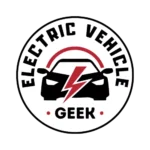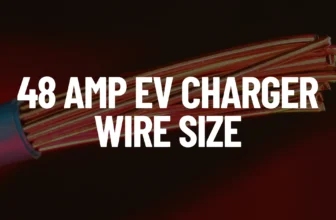Level 3 EV charging is emerging as the king of EV charging levels; EV owners want to pull up at a charging station and plug in their electric vehicle, and within minutes, their electric vehicle battery is juiced, ready to conquer the road. According to a recent McKinsey survey, 42% of surveyed EV owners prefer charging their EVs on Level 3 EV chargers, as shown in the chart below:
It’s understandable why 42% of EV owners favour Level 3 fast chargers, as they significantly reduce charging times compared to Level 1 or Level 2 chargers, offering convenience, accessibility, flexibility, range confidence, and technological advancements, which are pivotal in driving electric vehicle adoption.
For Level 3 EV charging, you’ll need access to a Level 3 charger at a public station. You can easily use our EV charging station map to find a Level 3 EV charger near you. While less common due to installation and hardware costs, you can opt for a Level 3 home or work charger.
What is Level 3 EV Charging?
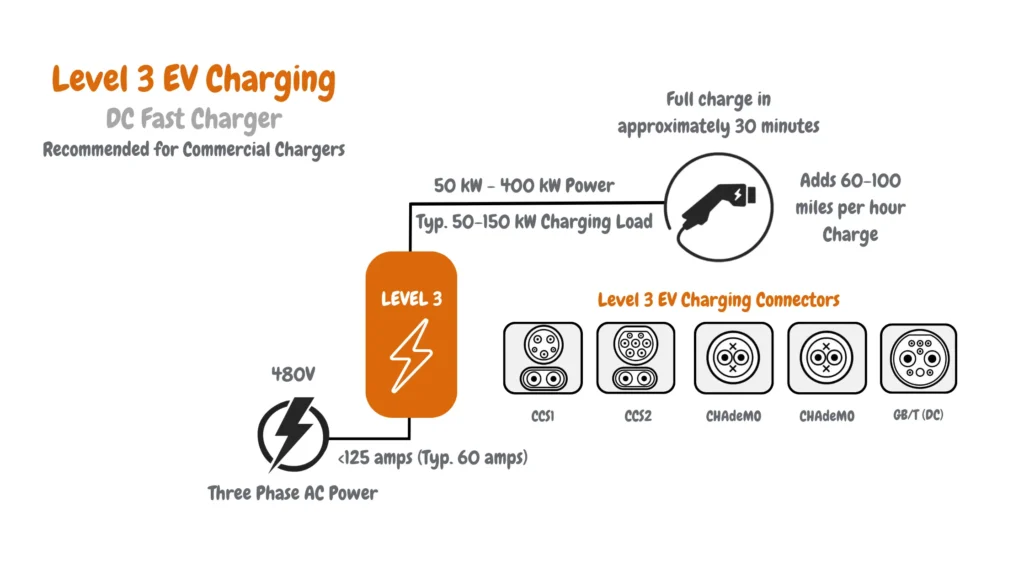
As shown in the Level 3 EV charging illustrative image above, These chargers typically range from 50 kW to 400 kW in power output, making them suitable for commercial installations due to their high capacity. They utilize a 480V power supply and can add approximately 60-100 miles of range per hour of charge, with a full charge achievable in around 30 minutes.
Level 3 charging connectors commonly include CCS1, CCS2, CHAdeMO, and GB/T (DC) (shown in the image above). The charging process involves a high charging load, typically between 50-150 kW, and requires a current of less than 125 amps, typically around 60 amps.
EV Charging Station Schematics
Level 3 EV charging stations integrate with the electrical grid for swift power delivery.
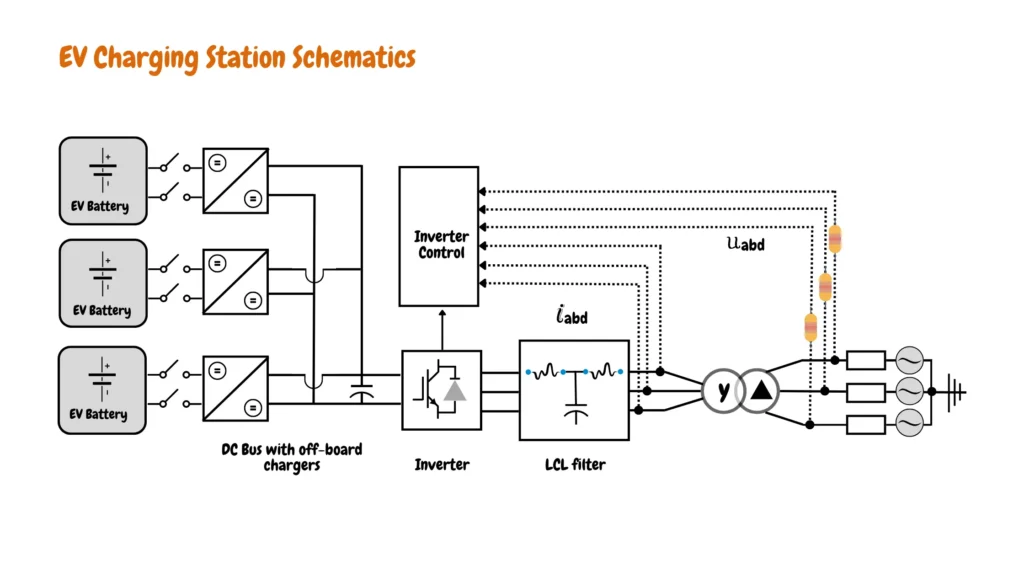
As shown in the EV charging station schematics above, electric vehicles (EVs) are connected to the charging station. Power electronic converters manage power flow: the grid-side converter (GSC) links the station to the grid, while EV-side converters (ESCs) regulate charging for each vehicle. These converters use current-regulated voltage-source PWM technology for efficient power transfer. The charging station connects to the grid through an LCL filter and transformer. EVs are plugged into designated slots on the DC bus. An integrated control system oversees the charging process, optimizing efficiency and safety.
What are Level 3 EV Chargers?
Why Is a Level 3 EV Charger Charging Slow?
One of the frequent questions we get from EV owners is why is the Level 3 charger I’m using charging slowly. Well …
The most common reason for slow charging with a Level 3 EV charger is the power output of the charging station. Below is a table outlining different charging speeds and the corresponding miles added based on the charging station’s power output.
| 50kW Level 3 Charger Power Output | 150kW Level 3 Charger Power Output | 200kW Level 3 Charger Power Output | 350kW Level 3 Charger Power Output | |
|---|---|---|---|---|
| 10 Minutes Charging Time | Miled Added: 20 | Miled Added: 60 | Miled Added: 70 | Miled Added: 125 (Sweet Spot) |
| 15 Minutes Charging Time | Miled Added: 30 | Miled Added: 90 | Miled Added: 105 | Miled Added: 185 |
| 20 Minutes Charging Time | Miled Added: 55 | Miled Added: 125 (Sweet Spot) | Miled Added: 140 (Sweet Spot) | Miled Added: 250 |
| 30 Minutes Charging Time | Miled Added: 80 | Miled Added: 190 | Miled Added: 215 | Miled Added: 375 |
| 45 Minutes Charging Time | Miled Added: 120 | Miled Added: 270 | Miled Added: 305 | – |
| 1 hour | Miled Added: 170 (Sweet Spot) | Miled Added: 360 | – | – |
This will help illustrate how variations in power output affect charging times and mileage gained, aiding in a better understanding of why the Level 3 charger you are using is charging slowly or charging speeds expected.
How Level 3 EV Chargers Work
Level 3 chargers operate on direct current (DC), directly filling your battery bucket much faster, unlike slower Level 1 and 2 chargers, which use a trickle-like flow of alternating current (AC); here is an illustrative diagram showing how Level 3 EV chargers work:
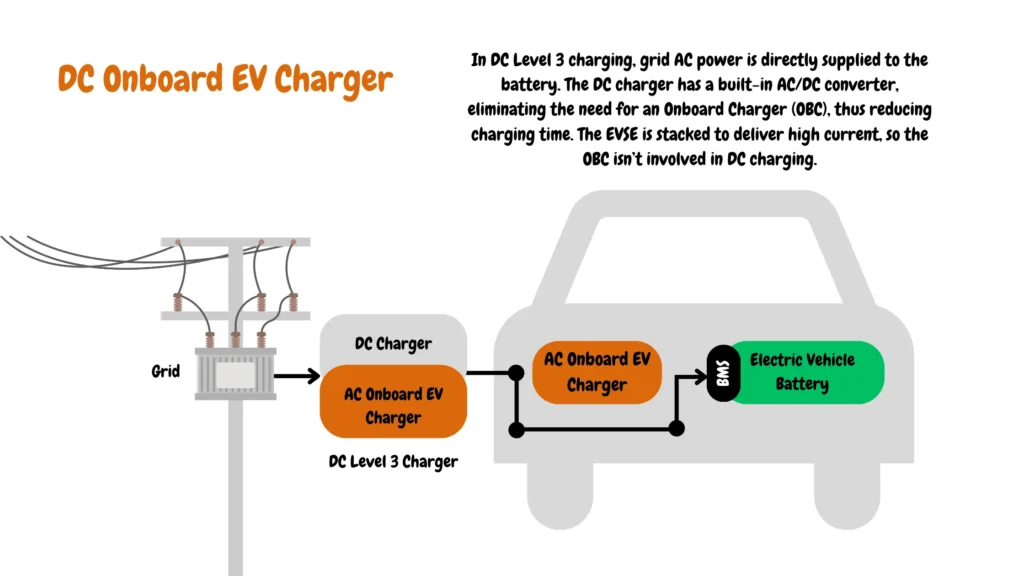
The Level 3 illustrative diagram above shows that Level 3 chargers operate on DC (direct current). This is crucial because most EV batteries store energy in DC form. With Level 1 and 2 charging, your car’s onboard charger converts AC to DC, adding an extra step to the process.
Level 3 chargers are built-in with offboard AC-DC converters (off-board AC-DC converters), allowing Level 3 chargers to perform this conversion themselves, delivering DC power directly to your battery, bypassing the electric vehicle onboard charger and accelerating the speed of EV charging.
Comparing Level 1, Level 2, and Level 3 EV Charging.
This infographic compares three electric vehicle charging levels: Level 1, 2, and DC Fast Charging (DCFC).
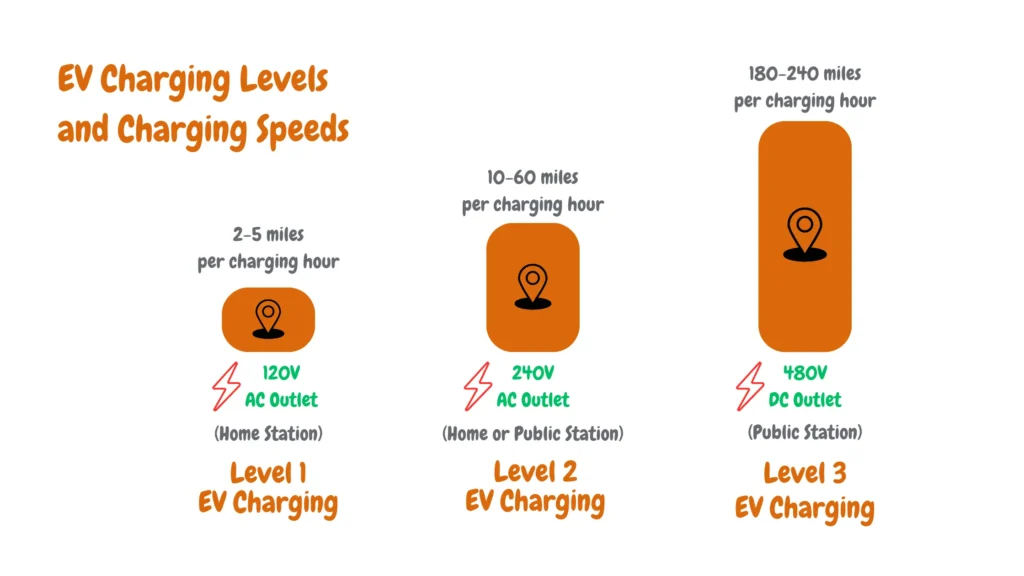
What Is Level 1 EV Charging?
Level 1 charging uses a standard 120-volt AC outlet, similar to what you would find in your home. It’s the slowest charging option but requires no special equipment.
What Is Level 2 EV Charging?
Level 2 charging uses a 240-volt single-phase electrical supply, which can charge your car much faster than Level 1. These chargers are typically found in homes, businesses, and public charging stations.
Level 3 charging
Level 3 charging/DC Fast Charging (DCFC) stations use a 480-volt three-phase power supply and require additional permitting due to the higher power involved. However, they can charge your car in minutes, making them ideal for long trips or quick top-ups.
Level 1 charging delivers a mere 1.4 kW, barely enough to keep your phone happy. Level 2 bumps it up to 3.3-19.2 kW, but Level 3 takes things to a new level (pun intended!) with outputs ranging from 50 kW to a mind-blowing 350 kW. That means adding 200 miles of range in just 15 minutes on some chargers!
| Feature | Level 1 (Slow & Steady) | Level 2 (Home & Away) | Level 3 (Fast Charge) |
|---|---|---|---|
| Charging Time | 6-22 hours (overnight) | 2-8 hours (faster top-up) | 30 minutes (quick boost) |
| Mileage Added per Hour | 3-5 miles | 20-60 miles | 100-300 miles |
| Power Source | Standard 120V AC outlet (like your home) | 208-240V AC outlet (common in homes & businesses) | High-voltage 480V, three-phase AC |
| Power Output | Low (1.3 – 2.4 kW) | Moderate (3 – 19.2 kW) | High (50 kW – 400 kW) |
| Connector Type | J1772 (common in North America) | Varies (Mennekes, Tesla, etc.) | DC Fast Charging (CCS, CHAdeMO, etc.) |
| Amps | Low (12-16 amps) | Moderate (12-80 amps) | High (<125 amps) |
| Charging Load | Low (1.4 – 1.9 kW) | Moderate (typical 7-10 kW) | High (typical 50-150 kW) |
| Ideal Use | Overnight charging at home | Home, workplace, public charging stations | Long trips, quick top-ups on the go |
Entities like SAE International and the National Electric Vehicle Infrastructure Training Partnership (NEVI) are actively involved in setting standards and ensuring the safety and compatibility of Level 1, 2, and 3 chargers.
Does DC Fast Charging Damage EV Batteries?
Due to the bypass of the electric vehicle onboard converter, high charging speeds, and high electricity requirements of Level 3 chargers, we have heard of concerns regarding the degradation of EV batteries, and unfortunately, the answer is:
Plus, advancements in battery technology are constantly improving, making them more resilient to faster charging. So, rest assured, you can enjoy the convenience of Level 3 charging without worrying about harming your EV’s battery.
Level 3 EV charging cost?
The Future of Level 3 Charging
The future of EV charging infrastructure in the US hinges on the growth of energy production to meet surging demands. By 2050, national power production must double to align with projected rates of EV adoption.
However, challenges loom, including needing more energy while curbing harmful emissions, modernizing ageing infrastructure, and reducing power losses within the distribution network.
Microgrids offer a solution, decentralizing energy production and storage to support EV charging infrastructure at the local level.
Utilities play a crucial role in this transformation. Collaboration among utilities, businesses, and communities is essential to build and integrate additional microgrid systems into the EV charging infrastructure.
Government initiatives, such as the investment of $14.7 million in microgrids for underserved communities and allocations in the Inflation Reduction Act for clean energy and EV charging, further bolster this transition.
In terms of technology, advancements in EV charging hold promise:
- Wireless or inductive charging could automate charging solutions, freeing EV drivers from traditional plug-ins.
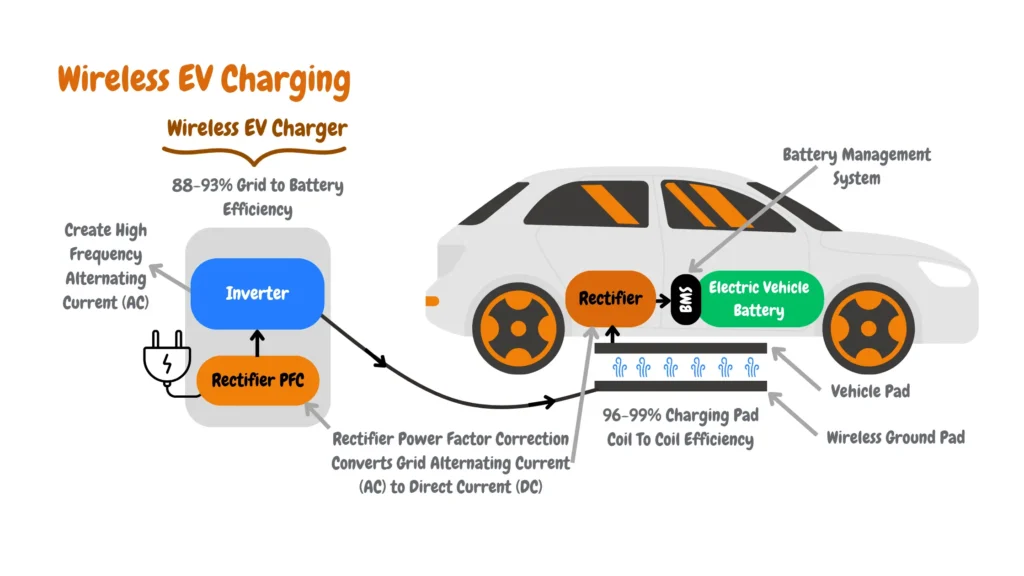
- High-speed charging enhances public charging convenience and supports evolving EV design standards.
- Bidirectional charging allows EVs to become mobile power sources, especially within microgrids.

- Dynamic charging explores smart road concepts to charge vehicles in motion.
- AI-driven smart charging solutions promise user-friendly experiences and market expansion.
- Portable charging addresses range anxiety with emergency chargers and mobile trailers.
- Solar charging integration in parking lots demonstrates sustainable progress, poised to increase with microgrid adoption.
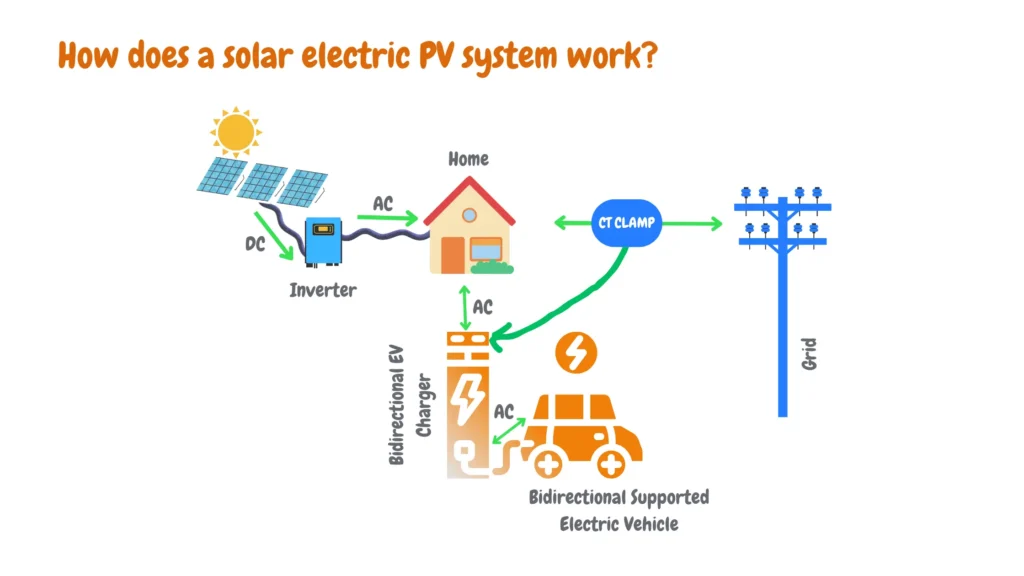

About the Author: James Ndungu
James Ndungu, founder and editor-in-chief of Electric Vehicle Geek, brings over five years of hands-on experience in Electric Vehicle Supply Equipment (EVSE) selection, permitting, and installation. He specializes in assisting businesses and homeowners in the United States with a seamless transition to electric vehicles.
As a certified EV charger installer and holder of advanced certifications, including the EVITP (Electric Vehicle Infrastructure Training Program), Diploma in Electric Vehicle Technology, and Diploma in Engineering Fundamentals of Electric Vehicles, I provide expert guidance and in-depth reviews on the latest EV charging equipment.
